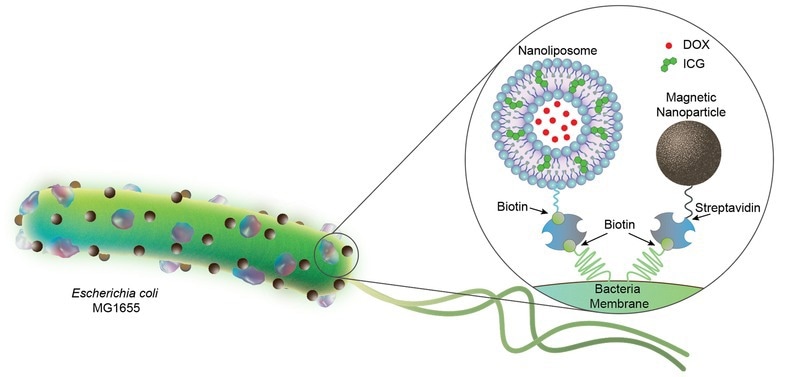A team of scientists from the Max Planck Institute for Intelligent Systems’ Physical Intelligence Department merged robotics and biology by outfitting E. coli bacteria with artificial components to create biohybrid microrobots. To begin, as shown in Figure, the researchers connected multiple nanoliposomes to each bacteria.
 Bacterial biohybrids carrying nanoliposomes (200 nm) and magnetic nanoparticles (100 nm). Nanoliposomes are loaded with chemotherapeutic DOX and photothermal agent ICG, and both cargoes are conjugated to E. coli bacteria (2 to 3 µm in length) via biotin-streptavidin interactions. Image Credit: Akolpoglu et al., Sci. Adv. 8, eabo6163 (2022).
Bacterial biohybrids carrying nanoliposomes (200 nm) and magnetic nanoparticles (100 nm). Nanoliposomes are loaded with chemotherapeutic DOX and photothermal agent ICG, and both cargoes are conjugated to E. coli bacteria (2 to 3 µm in length) via biotin-streptavidin interactions. Image Credit: Akolpoglu et al., Sci. Adv. 8, eabo6163 (2022).
These spherical-shaped carriers encapsulate a substance (ICG, green particles) on their outer circle that melts when irradiated with near-infrared light. Liposomes encapsulate water soluble chemotherapeutic drug molecules (DOX) farther towards the middle, within the fluid core.
Magnetic nanoparticles are the second component the researchers applied to the bacteria. When subjected to a magnetic field, the iron oxide particles increase the motility of this already mobile bacteria.
This makes controlling the movement of bacteria simpler—an enhanced design for in vivo use. Meanwhile, the rope that connects the liposomes and magnetic particles to the bacteria is an extremely stable and difficult to break streptavidin and biotin complex that was created a few years ago and can be used to build biohybrid microrobots.
E. coli bacteria are quick and adaptable swimmers that can move through a variety of materials, including liquids and very viscous tissues. But that is not all; they also have cutting-edge sensing capabilities. Bacteria are attracted to chemical gradients such as low oxygen levels or high acidity, both of which are common around tumor tissue.
Microorganisms-mediated tumor therapy is the treatment of cancer by injecting bacteria in close proximity. The bacteria migrate to the tumor, proliferate there, and therefore stimulate the patient’s immune system. Bacteria-mediated tumor therapy has been used as a treatment for over a century.
For decades, scientists have been looking for methods to boost this microorganism’s abilities even more. Researchers gave bacteria more components to assist them to fight the struggle. Adding artificial components, on the other hand, is a difficult process.
There are complex chemical interactions at work, and the density rate of particles placed onto the bacterium is important to minimize dilution. The Stuttgart squad has now set a very high standard. Researchers were able to implant liposomes and magnetic particles into 86 of 100 bacteria.
The scientists demonstrated how they were able to externally direct such a high-density solution along several paths. First, via an L-shaped thin conduit with two compartments on each end, each containing one tumor spheroid. Second, a much narrower arrangement mimicking microscopic blood veins.
Researchers demonstrated how they precisely direct the drug-loaded microrobots towards tumor spheroids by adding an additional permanent magnet on one side. Finally, the scientists guided the microrobots through a viscous collagen gel (similar to tumor tissue) with three degrees of stiffness and porosity, ranging from soft to medium to rigid.
The harder it is for bacteria to find a way through the matrix, the stiffer the collagen and the tighter the web of protein strings as shown in Figure. The researchers demonstrated that when they added a magnetic field, the bacteria were able to traverse all the way to the other end of the gel due to their increased force. Because of the continual alignment, the bacteria found a path through the threads.
Once the microrobots have aggregated at the target location (the tumor spheroid), a near-infrared laser emits beams with temperatures of up to 55 °C, causing the liposome to melt and the medications contained inside to be released. A low pH level or acidic environment also triggers the nanoliposomes to burst apart, resulting in the medications being released automatically near a tumor.
Imagine we would inject such bacteria based microrobots into a cancer patient’s body. With a magnet, we could precisely steer the particles towards the tumor. Once enough microrobots surround the tumor, we point a laser at the tissue and by that trigger the drug release. Now, not only is the immune system triggered to wake up, but the additional drugs also help destroy the tumor.”
Birgül Akolpoglu, Study First Author and PhD Student, Physical Intelligence Department, Max Planck Institute–Intelligent Systems
On July 15th, 2022, it was published in Science Advances.
This on-the-spot delivery would be minimally invasive for the patient, painless, bear minimal toxicity and the drugs would develop their effect where needed and not inside the entire body.”
Dr Yunus Alapan, Former Postdoctoral Researcher, Physical Intelligence Department, Max Planck Institute–Intelligent Systems
Prof. Dr Metin Sitti, the last author of the study from the Physical Intelligence Department concludes, “Bacteria-based biohybrid microrobots with medical functionalities could one day battle cancer more effectively. It is a new therapeutic approach not too far away from how we treat cancer today. The therapeutic effects of medical microrobots in seeking and destroying tumor cells could be substantial. Our work is a great example of basic research that aims to benefit our society.”
Source:
Journal reference:
Akolpoglu, M. B, et al. (2022) Magnetically steerable bacterial microrobots moving in 3D biological matrices for stimuli-responsive cargo delivery. Science Advances. doi.org/10.1126/sciadv.abo6163.